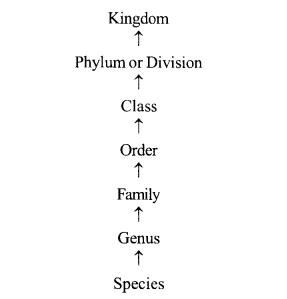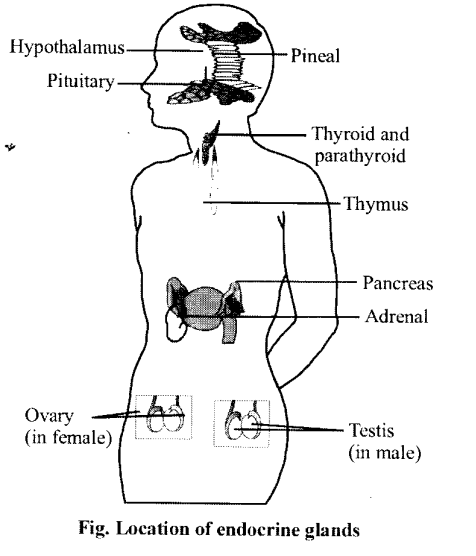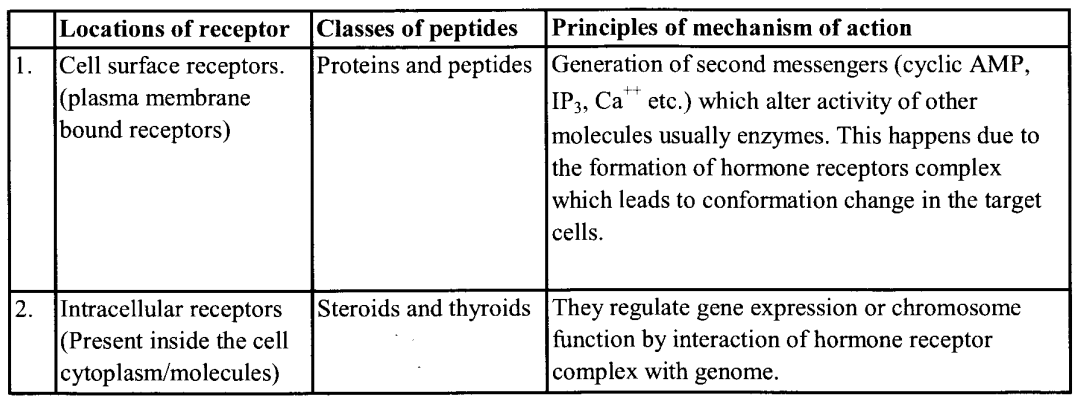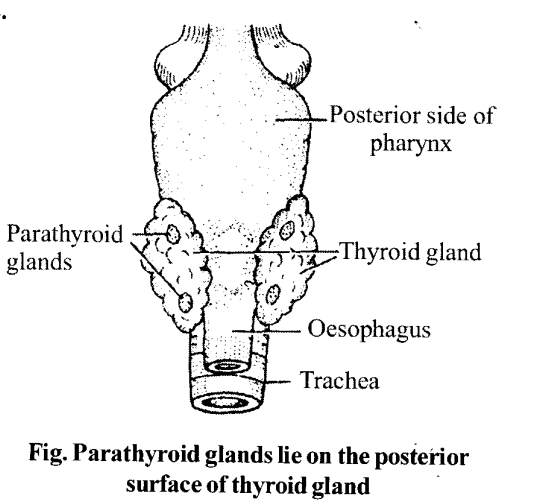NCERT Solutions for Class 11 Biology Chapter 1 The Living World
These Solutions are part of NCERT Solutions for Class 11 Biology. Here we have given NCERT Solutions for Class 11 Biology Chapter 1 The Living World.
Question 1.
Why are living organisms classified?
Solution:
Classification of living organisms grouped them in special categories, which is based on observable characters. It makes their study easy and convenient. For example, Mammals are those who possess mammary glands, the hair on the body, external pinnae, etc.
Question 2.
Why are classification systems changing every now and then?
Solution:
The classification system changes when more information becomes available about the organisms. Additional information are updated from time to time about different organisms at this stage there is a need arises to make changes in the classification system.
Question 3.
What different criteria would you choose to classify people that you meet often?
Solution:
Classification means the arrangement of organisms into groups on the basis of their affinities or relationships. The branch of biology that deals with the study of principles and procedures of biological classification are called taxonomy. Some fundamental elements of taxonomy are discussed below.
Nomenclature: It is the science of providing distinct and proper names to organisms. It is the determination of the correct name as per established universal practices and rules.
Classification: It deals with the mode of arranging organisms or group^ of organisms into categories according to a systematic plan or ah order. The categories used in the classification of animals are Class, Order, Family, Genus, and Species. Each category is a unit and is also called a taxon (PI. Taxa).
Identification: It is the determination of the correct name and place of an organism in a system of classification. It determines that the particular organism is similar to some other organism of known identity. This implies assigning an organism to a particular taxonomic group. Suppose there are three plants say x, y, z. AH represent different species. Another plant w resembles y. The recognition of the plant was identical to the already known plant y is its identification.
One of the important features of systematics is the naming of living organisms. The organisms have been given two types of names i.e
- common or vernacular names
- Scientific names.
Question 4.
What do we learn from the identification of individuals and populations?
Solution:
Identification of individuals and populations determines their exact place or position in the set plan of classification.
Question 5.
Given below is the scientific name of mango. Identify the correctly written name.
(a) Mangifera Indica
(b) Mangifera indica
Solution:
(b) Mangifera indica
Question 6.
Define a taxon. Give some examples of taxa at different hierarchical levels.
Solution:
“Taxon is a unit of classification or a rank or a level of hierarchy in system of classification. The following chart gives taxonomical categories showing a hierarchical arrangement in ascending order.
Kingdom
↑
phylum or Division
Class
↑
Order
↑
Family
↑
Genus
↑
Species
Question 7.
Can you identify the correct sequence of taxonomical categories?
(a) Species → Order → Phylum → Kingdom
(b) Genus → Species → Order → Kingdom
(c) Species → Genus → Order → Phylum
Solution:
(c) Species → Genus → Order → Phylum
Question 8.
Try to collect all the currently accepted meanings for the word ‘species’. Discuss with your teacher the meaning of species in the case of higher plants and animals on one hand and bacteria on the other hand.
Solution:
- Species is one of the basic units of biological classification. A species is often defined as a
group of organisms capable of interbreeding aid in producing fertile offspring. - Sometimes more precise or differing measures such as similarity of DNA, morphology o,^ecological niche are used to define the basis of species.
- In case of animals, the name of species is defined by the specific name or the specific epithet. For example, gray wolves belong to the species Canis lupus, golden Jackals to Cam’s aureus etc.
- Both of them belong to same genus Canis, but species name varies. But species name of plant is only called species epithet.
- The ‘specific name’ in botany is always the combination of genus name and species epithet such as saccharum in Acer saccharum (Sugar maple).
- But bacteria are grouped under four categories based on their shape – spherical, rod-shaped, comma and spiral shaped and species of bacteria is according to their shapes. Thus the meaning of species in higher organism and bacteria are different.
Question 9.
Define and understand the following terms:
(i) Phylum (ii) Class (iii) Family (iv) Order (v) Genus
Solution:
(i) Phylum: A phylum is a group of related classes having some common features, e.g., protozoa.
(ii) Class: A class is a group of related orders, for e.g., order Rodentia, Lagomorpha and Carnivora all having hair and milk glands are placed in class Mammalia.
(iii) Family: A family is a group of related genera. The genus Felis of cats and the genus Panthera of lion, tiger and leopard are placed in the family Felidal.
(iv) Order: An order is a group of related families. The family Felidae of cats and the »family Coridal of dogs are assigned to the order Carnivora. Cats and dogs have large canine teeth and are flesh-eaters.
(v) Genus: A genus is a group of species alike in the broad features of their organization but different in detail. As per the rules of binomial nomenclatures, a species can not be named without assigning it to a genus.

Question 10.
How is key helpful in the identification and classification of organisms?
Solution:
Keys are contrasting pairs of characters (couplet), it represents the choice made between two opposite options. This results in acceptance of only one and rejection of the other. Each statement in the key is called a lead. Separate taxonomic keys are required for each taxonomic category such as family, genus, and species for identification purposes.
Question 11.
Illustrate the taxonomical hierarchy with suitable examples of a plant and an animal.
Solution:

VERY SHORT ANSWER QUESTIONS
Question 1.
Name the basic Unit of classification.
Solution:
Species.
Question 2.
Who introduced the hierarchy in taxonomy?
Solution:
Linnaeus
Question 3.
Who is the father of taxonomy?
Solution:
Carolus Linnaeus.
Question 4.
What is meant by cytotaxonomy?
Solution:
Classification based on chromosome number.
Question 5.
Who devised the binomial nomenclature?
Solution:
Carolus Linnaeus
Question 6.
What is a type specimen?
Solution:
Establishment of the name of the new species on the basis of the original specimen is called type specimen
Question 7.
In which language binomial nomenclature is written?
Solution:
Latin
Question 8.
What term is used to describe organisms without a well-developed nucleus?
Solution:
Prokaryote
Question 9.
Is inter-specific breeding possible?
Solution:
Yes, both.
Question 10.
What are DNA viruses / RNA viruses?
Solution:
Viruses that possess DNA as the genetic material are called DNA viruses.
Question 11.
What is speciation?
Solution:
Formation of a new species from an existing one by the appearance of mutation.
Question 12.
What are correlated characters?
Solution:
The common features the species have to qualify for inclusion in a genus are called correlated characters
Question 13.
Why classification of plants and animals is necessary?
Solution:
Classification divides millions of plant and animal species into convenient groups that make their study easier
Question 14.
What is cohort or order?
Solution:
The cohort is a unit of classification higher than the 6. family
Question 15.
Give an example of symbiotic bacteria.
Solution:
Rhizobium leguminosarum
Question 16.
Give botanical and zoological names of the following:
(1) Pea
(2) Wheat
(3) Man
(4) Potato
Solution:
(1) Pea → Pisumsatinum
(2) Wheat → Triticumaextivum
(3) Man → Homo sapiens
(4) Potato → Solanum tuberosum
SHORT ANSWER QUESTIONS
Question 1.
Write a note on bacteriophages. (Dharwar. 2004, Belgaum. 04,2005)
Solution:
The viruses that infect bacteria are called bacteriophages. They were discovered by Twort. They are Tadpole shaped. They have DNA as their genetic material. They are distinguished into T – odd phages as well as T – even phages.
Question 2.
What is a taxonomic aid?
Solution:
A taxonomic aid is storage of record of either live or dead specimens of flora or fauna, which helps scientists in taking reference to study classification
Question 3.
Give the classification of man.
Solution:
Common Name – Human
Scientific Name – Homo sapiens
Genera – Homo
Families – Hominidae
Orders – Primata
Classes – Mammalia
Phyla/Division – Chordate
Question 4.
What is a museum? How many kinds of museums are found?
Solution:
Museum in an institution where artistic and educational materials are exhibited to the public. The material available for observation and study is called a collection.
Kinds of Museums:
- Art Museum
- History Museum
- Applied Science Museum
- Natural Science Museum
Question 5.
Give a reason for the following.
Bacteria are the Natural Scavengers ‘ (D.Kannada 2006)
Solution:
because they bring about the decomposition of organic debris and clean the earth’s surface.
Question 6.
What is the role of characteristics of living beings in classification?
Solution:
A group of common features of living beings are placed under a common category of classification and when uncommon under a different category. It means more systematic a process for further study, research, protection and recording.
Question 7.
What is the significance of a HERBARIUM?
Solution:
HERBARIUM:- A book, case, or room containing an orderly collection of dried plants is called Herbarium. It develops interest in Nature for the activists in it. It can be used to gain knowledge and be updated about plants and their scientific names and even compare various samples. It is a small scale it can be proactive to do. One can make projects too from it for schools, colleges and research institutions.
Question 8.
Explain the role of blue-green algae in soil fertility.
Solution:
Blue-green algae like Nostoc, Anabaena fix atmospheric nitrogen. Heterocyst contains nitrogens enzyme that helps in nitrogen fixation. Nitrogen-fixing blue-green algae are inoculated in the rice field to increase soil fertility.
LONG ANSWER QUESTIONS
Question 1.
Write a short note on Binomial Nomencia? ture and guidelines for Binomial nomenclature.
Solution:
Binomial Nomenclature was introduced by Carolus Linnaeus. In this method every organism is given a scientific name, which has two parts, the first is the name of the genus (generic name) and the second is the name of the species (specific epithet) e.g.: Homo sapiens In the above examples, Homo is a generic name, while sapiens is the name of the species belonging to Homo.
Guidelines:
- scientific names are generally in Latin or derived from Latin irrespective of their origin
- The scientific names are written in italics or underlined (when handwritten)
- The first word denotes the name of the genus and the second word denotes the specific epithet
- The generic name starts with a capital letter, while the specific name starts with a small letter (If a specific name starts with a capital letter it denotes the name of a person or place)
- The name of the author is written in an abbreviated form after the specific name. e.g.: Homo sapiens Linn.
Question 2.
What is the difference between living and nonliving?
Solution:
Question 3.
Explain the binomial system of nomenclature.
Solution:
Binomial nomenclature system was developed by Linnaeus. Binomial nomenclature is the system of providing organisms with appropriate and distinct names consisting of two words, first generic and second specific. The first or 4.
- generic word is also called genus. It is like a noun and its first letter is written in capital form.The second word or specific epithet represents the species.
- It is like an adjective. Its first letter is written in small form except occasionally when it denotes a person or place. The two word name is appended with the name of the taxonomist who discovered the organism and provided with its scientific name, e.g., Ficus bengalensis L., Mangifera indica Linn, The name of taxonomist can be written in full or in abbreviated form.
- There are several technical names which have three words, e.g., Homo sapien sapiens, Acacia nilotica indica, Gerilla gorilla. Here the first word is generic, the second specific while the third word represents variety (mostly in botanical literature) or subspecies (mostly in zoological literature).
- If the same scientific name is to be written time and again, the name of the genus can be abbreviated, e.g., F. bengalensis.
Question 4.
What is the role of zoological parks in wildlife conservation?
Solution:
- In the early stages, the zoological parks were considered as places of relaxation and enjoyment for public, however, there has been a change in the objective of the purposefulness of these parks.
- The establishment of zoological parks help in providing knowledge about different native and exotic wild mammals, birds, reptiles, fish and flora to the public in general and school children in particular.
- Since the key to wildlife conservation lies in the education of the masses and the involvement of voluntary organisations, zoological parks are very useful in spreading knowledge on the wildlife wealth of the country.
- These are also important centres for organising seminars, training and researches on the management of wildlife species and for study of their social behaviour, breeding and ecological species.
We hope the NCERT Solutions for Class 11 Biology at Work Chapter 1 The Living World, help you. If you have any query regarding NCERT Solutions for Class 11 Biology at Work Chapter 1 The Living World, drop a comment below and we will get back to you at the earliest.


